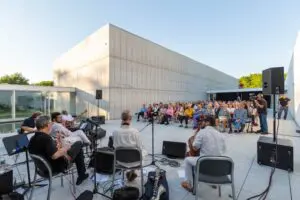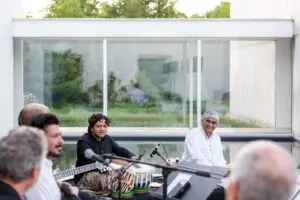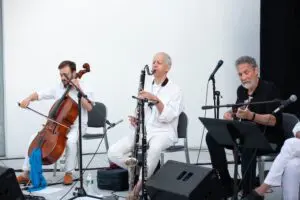Jog Blues ensemble will demonstrate at Magazzino
An eight-piece band with sitar and electric guitar that plays a mélange of jazz and Indian classical music should make strange bedfellows, yet both genres revere improvisation and share at least 60 years of intermingling.
On Saturday (June 15), the Jog Blues ensemble, which mashes the musical forms together and has performed at the Metropolitan Museum of Art and the Cathedral of St. John the Divine, will tour spiritual horizons and multifaceted musical avenues at Magazzino Italian Art in Philipstown.

The group emerged in 2013 after Jonathan Rose, chair of the Garrison Institute, a retreat center that he describes as a “think-and-do tank,” met Dr. Siddhartha Mukherjee, the Pulitzer Prize-winning author of The Emperor of All Maladies: A Biography of Cancer, at a party.
The conversation turned to the theoretical crossover between jazz and ragas, a key component of Hindu-based Indian classical music that provides a framework for soloing, similar to repeated sequences of chord progressions in a jazz or blues song.
“Jog is a midnight raga whose notes correspond with the blues scale,” the foundation of jazz, says Rose. “Ragas are related to times of the day, like a contemplative sunrise or a bright piece for a sunny afternoon. Each one has a different feel that colors the mind.”

Long a fan of free-wheeling experimentation, Rose in 1979 founded Gramavision Records, which focused on avant-garde artists like guitarist John Scofield, opera composer Anthony Davis, saxophone innovator Oliver Lake, contemporary classical unit Kronos Quartet and the jazz-funky fusion trio Medeski Martin & Wood.
“Jog Blues is certainly not the first to fuse jazz and Indian classical music,” says Rose, pointing to My Goal’s Beyond, a 1971 album from John McLaughlin that incorporates tabla drums and the tanpura, a drone instrument with four strings. “Indian drones, or an electric-guitar simulation of them, have infiltrated Western pop music since The Byrds and the Beatles.”
Sitar star Ravi Shankar influenced jazz saxophone icon John Coltrane, taught George Harrison how to play the multi-stringed instrument and released the album West Meets East in 1967 with classical violinist Yehudi Menuhin.
That same year, Shankar performed at the Monterey International Pop Festival. A live album culled from the set reached No. 43 on the pop charts. He also played at Woodstock.

After tinkering with various personnel, Rose and Mukherjee decided to counterbalance the sitar and tabla with guitar, bass and drums — the key building blocks of an electrified blues band.
Mukherjee’s vocals provide additional color. Cellist Jake Charkey is trained in Western and Indian music. Andy Biskin, who adds jazzy brush strokes on clarinet and bass clarinet, worked with folklorist Alan Lomax. At the Saturday show, the group plans to play a historic American religious song.
Rose, who plays bass and harmonica, has jammed with electric guitarist Joel Bluestein since college. “We look at each other and know what we’re going to play,” he says.
Sitarist Abhik Bhai performs with Brooklyn Raga Massive, a collective that blends the amorphous Indian classical approach with styles from jazz to world music.
For thousands of years, the Indian idiom existed as “a mixed tradition that absorbed everything, including Muslim influences,” says Mukherjee.
He showcases its diversity by presenting the Sufi mystical style known as Qawwali, whose most famous practitioner, the late Nusrat Fateh Ali Khan, worked with Peter Gabriel.
Unlike jazz, where several soloists take turns, the historic Indian musical canon is almost always performed in a dueling duet with a melodic instrument and tabla, says Mukherjee.
Naren Budhkar, who plays tabla, is the current go-to for La Monte Young, an influential figure in New York City’s minimalist music scene since 1960 who also recorded with Gramavision.
Though jazz drummers beat their cymbals and drums with a stick, tabla players almost massage the drumheads with their hands, pressing inward to vary pitch and tone. The lurching, cyclical beats sound like a soothing, gurgling water flow.
Pheeroan akLaff brings extensive experience playing experimental music and knows how to blend in on drums rather than bash away. Also an alumnus of Gramavision, he led a session for the album Fits Like a Glove (1983) and recorded with Anthony Davis and Oliver Lake.
Post-Woodstock, Ravi Shankar expressed revulsion after realizing that many American fans sought to achieve a spiritual awakening by listening to his music and mind-surfing on drugs.
The intent on Saturday, says Rose, is to channel the divine — sans far-out substances (unless you count beer, wine and prosecco): “Our sets are designed to take people on a contemplative mind- and heart-opening journey.”
Magazzino is located at 2700 Route 9 in Philipstown. The concert begins at 7 p.m. Tickets are available at magazzino.art for $25 ($20 for seniors and local residents, $5 for children and students).

